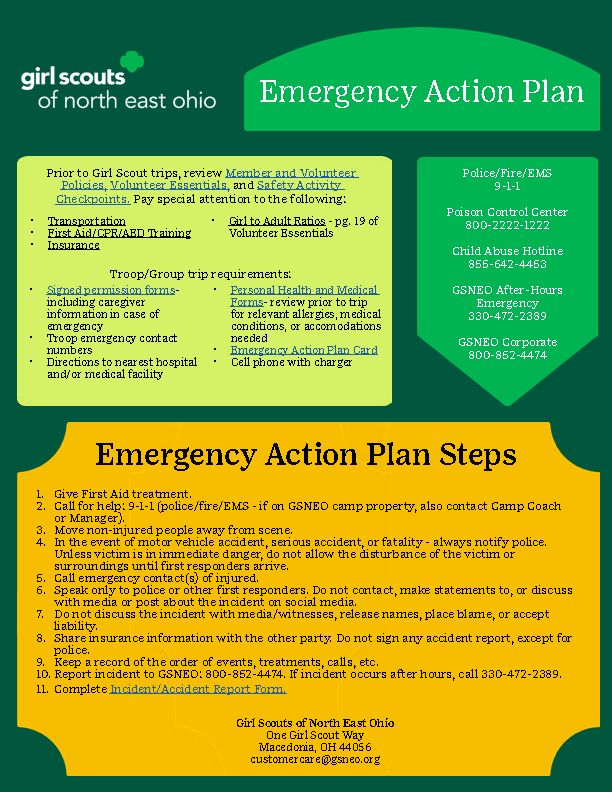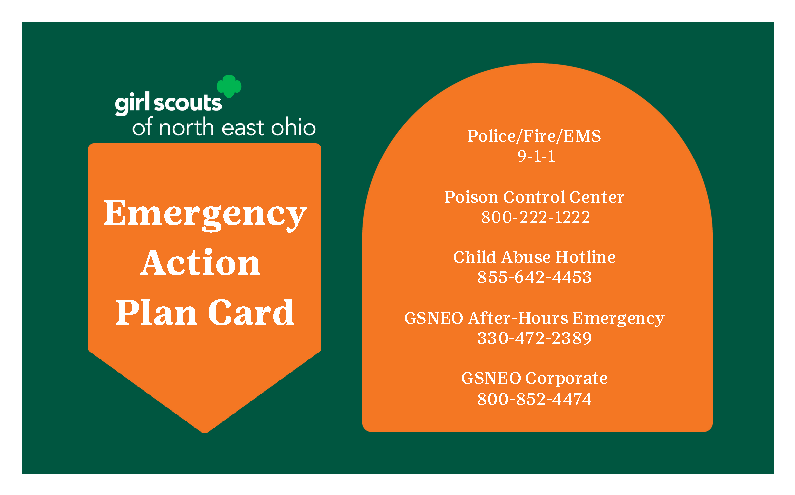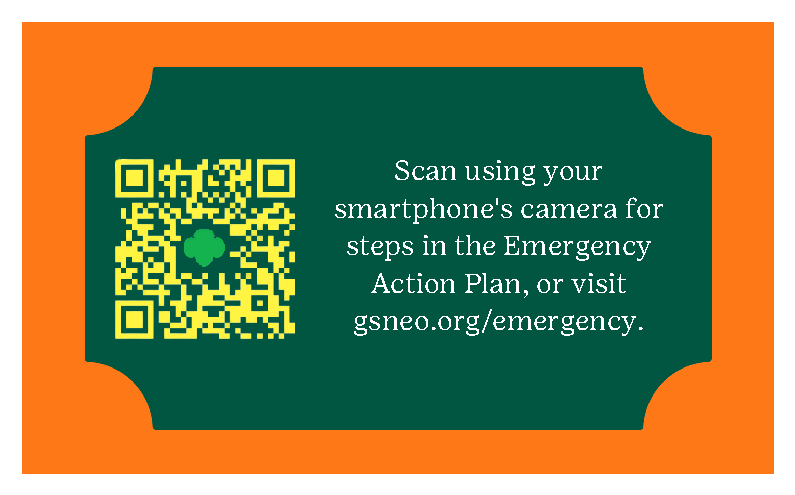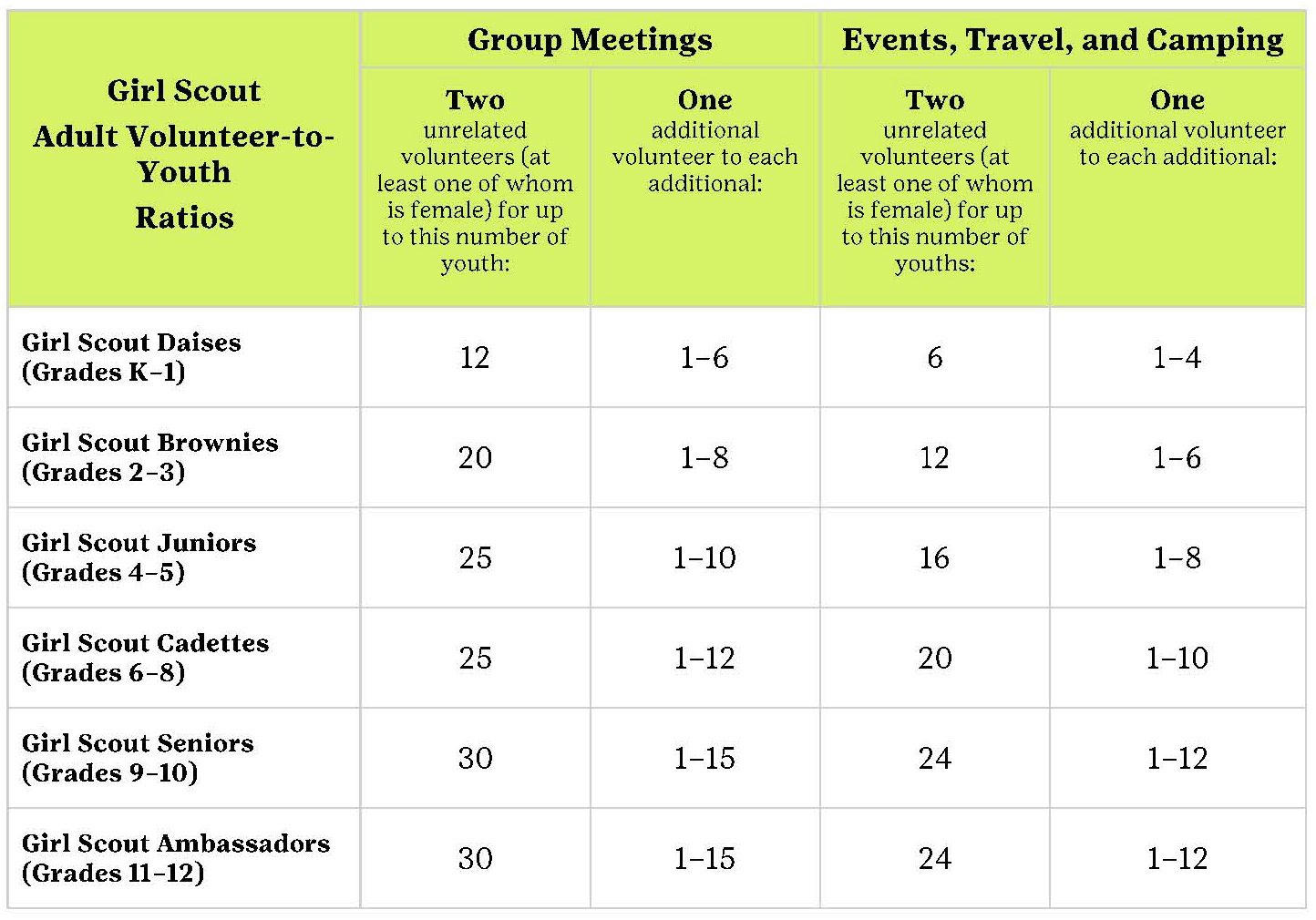Click the image to view interactive full screen version or to download and print.
Stay safe out there!
Nothing is more important than ensuring the health and safety of girls, whether they’re engaged in a real-world activity or exploring online.
At Girl Scouts, we work hard to build safety consciousness in adults, training staff, volunteers, and girls so that we can ensure proper supervision, prevent accidents and incidents, and maintain program resources.
Emergency Action Plan Card
The Emergency Action Plan should be carried by volunteers at all times - that's why we've created a wallet sized card with a QR code to easily access the steps in the Emergency Action Plan. The online version of the Emergency Action Plan - Steps is an interactive tool with links to important forms and documents you need before planning a troop outing. This document can be printed and stored in a trip binder. Be sure to screenshot the Emergency Action Plan - Steps for a convenient copy in your smartphone's camera library!

Safety Activity Checkpoints
When preparing for any activity with girls, always begin with the Safety Activity Checkpoints (SACs) written specifically for that activity.
Personal Health and Medical Report Form
This health history form is used for troop meetings, overnight trips, or other programs not exceeding 72 hours. This form should be kept in a confidential file for easy reference, and is typically filled out by youth caregivers and adult participants annually.
Permission Forms
To be considered a Girl Scout trip/activity, the troop/group leader must provide parents/caregivers with written details (date, time, locations, and brief description) of the trip/activity prior to its occurrence. The trip/activity must meet all requirements in Safety Activity Checkpoints (PDF), and either the Annual Permission Form (PDF) or Single Activity Permission Form (PDF) must be signed by the parent/caregiver and returned to the troop/group leader.
The Annual Permission Form (PDF) allows for troop trips/activities that are 1) located within one hour’s driving time of the regular meeting place, 2) not exceeding 6 hours, and 3) not considered high risk activities as outlined in Safety Activity Checkpoints (PDF) (ex: high ropes, zip line, equestrian). Trips/activities outside of these parameters require a separate Single Activity Permission Form (PDF). In addition, the Activity Consent, Hold Harmless and Release Agreement Form (PDF) may be required, depending on the activity. Girls participating in summer camp programs or trips lasting longer than 3-days will need to have the Summer Camp & 3-day Travel Health History Form filled out.
Activity Consent, Hold Harmless and Release Agreement Form
The Activity Consent, Hold Harmless and Release Agreement Form (PDF) should be completed by the parent/caregiver of youth participants, or by adult participants whenever the event, program, or activity includes one of the following high risk activities:
- Zip Line
- Low Ropes
- Scuba Diving
- Rock Climbing
- White Water Rafting
- High Ropes
- International Travel
GSNEO Equine Waiver no longer required
Follow Safety Activity Checkpoints and indicate the activity on Activity Consent Hold Harmless and Release Agreement.
Incident/Accident Report Form
Even though this form may be titled “Incident/Accident Report Form,” please keep in mind that it is NOT just for use when an injury occurs. Volunteers are to submit an Incident/Accident Report even if emergency care is not required.
Many different types of incidents should be reported to GSNEO for follow-up, including any conflict that occurs in a Girl Scout setting.
Some examples of situations that would merit a report being filed include:
- A girl falls at camp and skins her knee
- The money box is stolen from a cookie booth
- A bullying situation occurs at a troop meeting
- A parent volunteer gets into a fender-bender while transporting girls to an event
- Two parents with shared custody engage in a conflict in front of girls
- A window is accidentally broken during a meeting
- Reporting an infectious disease at a Girl Scout event
The Emergency Action Plan card, health forms, and permission slips should be on hand at all times.
Girl Scouts Volunteer-to-Youth Ratio Chart
Click the image to view a full screen version or to download and print.






